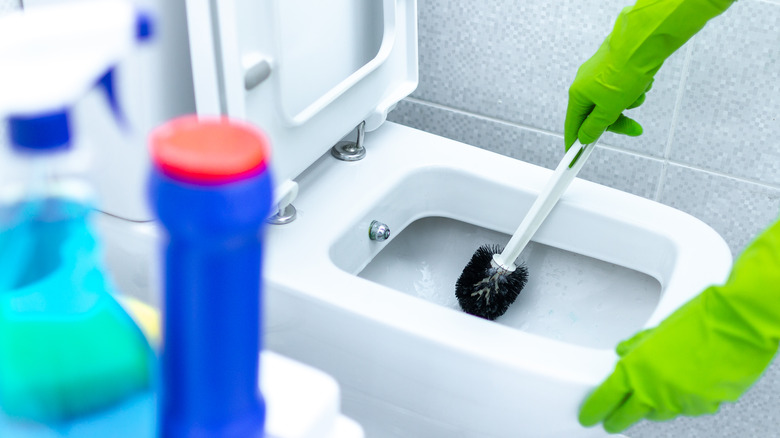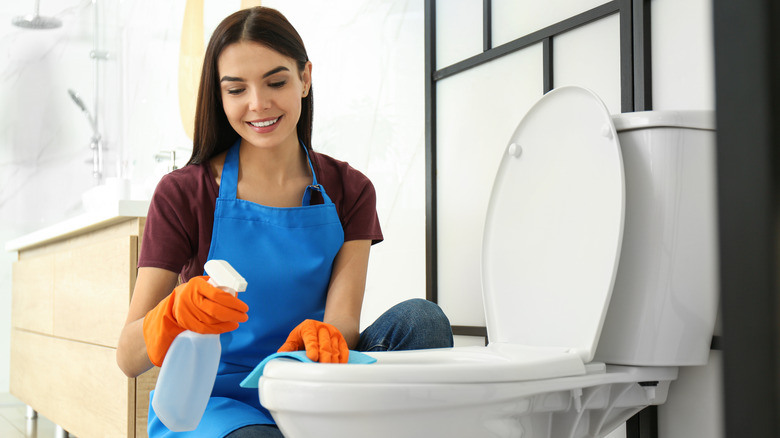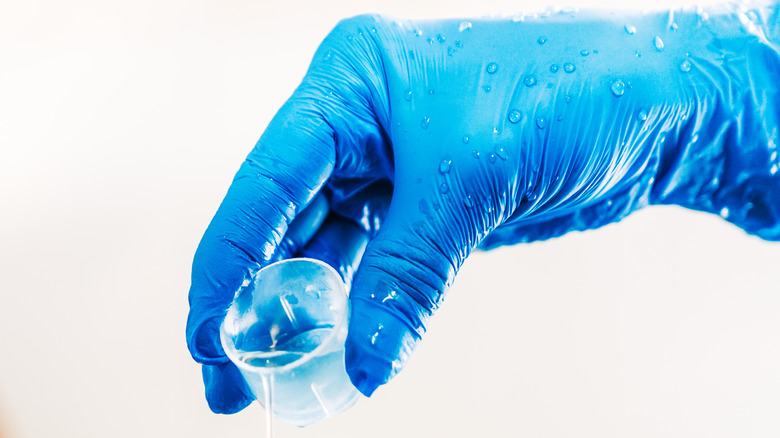Cleaning Your Toilet With Bleach Is A Health Risk If You Make This Mistake
You know it's time to break out those cleaning supplies when your toilet bowl starts to look a little grimy. Maybe it's developed a little discoloration, or perhaps even a funky smell. Either way, it's time to get to work and slap on those rubber gloves.
The importance of routine toilet cleaning goes well beyond appearance, however. Rather, letting gunk accumulate in your toilet allows pathogens to thrive. A 2021 scientific review published in the Journal of Applied Microbiology outlines how Salmonella bacteria can lurk on the bottom of toilet seats for as long as 50 days. Not only that, but with every flush, germs are dispersed into the air and can land across neighboring surfaces and items like your sink, or worse, your toothbrush. Pathogen spread is even more likely in the event that a person experiences diarrhea, as this increases the risk of splatter within the toilet bowl.
Thankfully, bleach can help us eliminate any viruses, bacteria, or fungi that may be hiding out in our toilet. Even better, it's fast-acting. Diluted household bleach can effectively kill off contaminants in mere minutes or within an hour at most, according to research published by the World Health Organization (WHO). However, bleach can be dangerous if you couple it with other cleaning agents.
Don't combine bleach with toilet bowl cleaner, ammonia, or vinegar
While it may sound like a logical mix, blending bleach and toilet bowl cleaner can potentially lead to serious health outcomes. This is because using bleach and acid-based toilet bowl cleaners simultaneously produces chlorine gas, explain experts at Reader's Digest. Even more, it doesn't take much before a person may experience coughing or respiratory issues, along with eye, nose, or throat irritation. Extreme levels of chlorine gas exposure can be fatal. Likewise, much like toilet bowl cleaner, combining bleach with ammonia releases chloramines, which can also cause similar side effects. This includes ammonia-containing products too, such as Windex.
But ammonia and toilet bowl cleaner aren't the only products that can be hazardous when combined with bleach. The same goes for vinegar, which, together, also gives off chlorine gas. In addition to eye, throat, and nose irritation, individuals may experience nausea, vomiting, or chest tightness. "In large volumes, the gas has an extremely pungent smell and looks yellow-green[.] [H]owever in small quantities, it's almost invisible and this is what actually makes i[t] dangerous," Dean Davies, cleaning supervisor for specialist sanitation services company Fantastic Services, tells Reader's Digest.
How to safely clean your toilet with bleach
Perhaps posing the greatest health risks is the blending of bleach and rubbing alcohol. While rubbing alcohol can be a powerhouse cleaning agent on its own, adding bleach to your toilet bowl will produce hydrochloric acid, chloroacetone, and chloroform — which can give off a sweet aroma (via Reader's Digest). Even in small amounts, one is susceptible to nausea or dizziness. In greater amounts, a person is at risk of kidney damage, along with eye, lung, skin, liver, and nervous system damage. In the event that these two chemicals mix, leave the bathroom immediately to allow it time to air out. Then, add a significant amount of water into the toilet bowl before flushing.
When it comes down to it, the only thing we should really be mixing with bleach is water. To effectively clean your toilet, combine 1 gallon of hot water with 1 tablespoon of bleach and spray away (per Better Homes & Gardens). Don't forget to hit the underside of the toilet seat and all around the edges of the bowl. Use a toilet brush along with a little elbow grease, and leave the solution in place for five minutes before sending it spiraling down the drain. Overall, experts suggest cleaning and disinfecting your toilet on a weekly basis (via Architectural Digest). However, you'll want to increase your toilet-cleaning frequency if a friend or family member has recently been ill.



